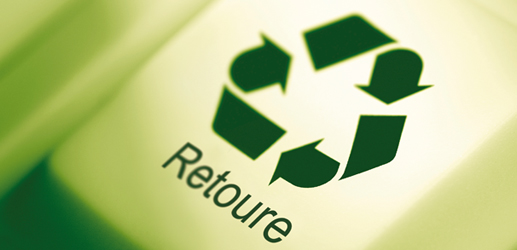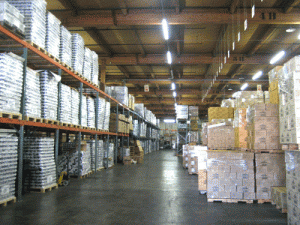How efficient is your reverse supply chain?
 In today’s business scenario, efficient supply chain is the key element of the company’s success. Corporate have realized that when they spend more time and money in fine-tuning their forward supply chains they can no longer ignore their backward (reverse) supply chains. Efficient reverse supply chains bring many benefits to the organization. However, reverse supply chains are different from forward supply chains and the fact remains that quite a few of the existing forward supply chains are not designed to handle reverse supply chains.
In today’s business scenario, efficient supply chain is the key element of the company’s success. Corporate have realized that when they spend more time and money in fine-tuning their forward supply chains they can no longer ignore their backward (reverse) supply chains. Efficient reverse supply chains bring many benefits to the organization. However, reverse supply chains are different from forward supply chains and the fact remains that quite a few of the existing forward supply chains are not designed to handle reverse supply chains.
Reverse supply chain stands for all operations related to the reuse of products and materials. It is the process of planning, implementing, and controlling the efficient, cost effective flow of raw materials – in-process, in inventory, finished goods and related information from the point of consumption to the point of origin for the purpose of recapturing value or proper disposal. More precisely, reverse logistics is the process of moving goods from their typical final destination for the purpose of capturing value, or proper disposal. Remanufacturing and restoring or renovating activities also may be included in the definition of reverse logistics. The reverse logistics process includes the management and the sale of surplus as well as returned goods. In the case of reverse logistics, the resource goes at least one step back in the supply chain management; often a move from the customer to the distributor or to the manufacturer.
When a manufacturer’s product normally moves through the supply chain network, it is to reach the distributor or customer. Any process or management after the sale of the product involves reverse logistics. If the product is defective, faulty, dangerous, or when goods are not described properly, or in price disputes, or when goods are lost in transit and found later in any such circumstances the goods are returned. The manufacturing firm would then have to organize shipping of the defective product, testing the product, dismantling, repairing, recycling or disposing off the products. It is understood here, that the product would travel in reverse cycle through the supply chain network in order to retain any use from the flawed product. The logistics for such theme calls for entire reversing process. Reverse logistics is more than reusing containers and recycling packaging materials, or redesigning packaging to use less material, or reducing the energy and pollution from transportation.
It is important because it also includes processing of returned merchandise due to damage, seasonal inventory, restock, salvage, recalls, and excess inventory. It also includes recycling programs, hazardous material programs, obsolete equipment disposition, and asset recovery etc.
The elements of Reverse Logistics are as follows:
Physical Movement of Goods: Differentbusinesseshavedifferent methods of handling reverse supply chain management. Usually customers return the goods from the place of purchase. It is the retail outlet most of the times where they go and return the goods. In the era of ecommerce a customer could be mailing the goods, or drop them off at designated locations. Some merchants will organize for a pickup of the goods from the customer’s location.
 Warehousing: The physical goods that are collected need to be tagged, tracked, and stored. This is the purpose of the warehousing process. A warehouse is typically a large storage space usually set up on the outskirts of towns or cities. In addition to storage space, these days the warehouses are well equipped with many devices and automated processes to tag and track the stored goods. An emerging technology, radio-frequency identification (RFID) holds substantial promise in the area of warehouse layout, receiving, order selection, and shipping. Because of the large number of different products processed and handled in a typical distribution center, RFID technology has great potential to improve operational efficiency.
Warehousing: The physical goods that are collected need to be tagged, tracked, and stored. This is the purpose of the warehousing process. A warehouse is typically a large storage space usually set up on the outskirts of towns or cities. In addition to storage space, these days the warehouses are well equipped with many devices and automated processes to tag and track the stored goods. An emerging technology, radio-frequency identification (RFID) holds substantial promise in the area of warehouse layout, receiving, order selection, and shipping. Because of the large number of different products processed and handled in a typical distribution center, RFID technology has great potential to improve operational efficiency.
Triage: Triage means sorting of goods based on their condition or quality. Some of the goods need to be repaired and sent back. Others have to be sold off as used defective goods. Some need to be sold as scrap. For making these vital decisions as to what can be done with returned goods, triage is the important step in reverse logistics.
Repair: Repairs are an important process as well in the reverse logistics supply chain. By repairing the goods, they can either be returned to the customer or they can be of use for reselling. Cost effective repairs can enable the reverse logistics centre to actually become a profit center. In fact, the business model of several third party reverse logistics providers depends upon selling refurbished products at high markups. Some even go ahead to actually provide warranties on the revamped goods.
After Sales Support: suppose customer ‘A’ returned goods; and these goods are repaired, repacked and sold to customer a new customer ‘B’, here the reverse logistics provider has become the new seller. In case the refurbished products are sold by the original manufacturer, all aspects of after sales support, such as: servicing the product and supporting it with an annual maintenance contract (AMC) are required even in the case of goods sold second-hand.
 Using a Third Party Reverse Logistics Provider: Just like the logistics of an ecommerce merchant can be outsourced to a third party logistics provider, there are specialist third party providers of reverse logistics too. These are organizations that specialize in receiving goods from customers, refurbishing them, and selling them at steep discounts.
Using a Third Party Reverse Logistics Provider: Just like the logistics of an ecommerce merchant can be outsourced to a third party logistics provider, there are specialist third party providers of reverse logistics too. These are organizations that specialize in receiving goods from customers, refurbishing them, and selling them at steep discounts.
The key reverse logistics activities are as follows:
Gate keeping: It is the process of screening unwarranted and defective commodities at the entry point. In the current economic climate, while it is not easy to manage the forward flow of products to customers, reverse flow becomes all the more difficult to handle. But not thinking about the reverse flow of products could mean missing imperative opportunities for guiding a company through tough times. Effective returns management can provide additional means of positively impacting a firm’s financial performance as well as building stronger relationships with key customers. When the returned product is re-entered into the inventory ledger, it starts incurring inventory carrying costs, and takes up warehouse space. Each of this logistical activity is expensive and must be considered part of the total cost of returns, beyond the negative adjustment to sales. Therefore efficient gate keeping is a must.
Compacting the recycling time is essential: When returned products come back to the distribution centers, the disposition methods should be kept as simple as possible so as to save time and cost both. The returned items must be tracked and stored at a central repository, by the use of an information system in place. Centralized return centers system are better to put in order all the products of reverse logistics from sorting, processing, storing, and resending to the next destination level under strict scrutiny in documented time.
Making best use of reverse supply chain: Many firms use reverse supply chain in effective way to get the benefit out of it. It reduces their operating costs by reusing products or components. Instead of destroying the products entirely organizations are setting up reverse supply chain modules to reduce the volume of destroyed products by half. Companies have started realizing the importance of reusing products or components; as a result, reverse supply chains are becoming essential part of business models. By cleaning up or clearing the distribution channel more often, bringing back outmoded and outdated or clearance items becomes easy. For example, Xerox replaces or upgrades hundreds of office printing machines every month. In India, Wipro is also using reverse supply chain to best use.
At IBM reverse supply chain process is explored systematically. The company conducts a lot of research for upgrading and refurbishing at this stage. In addition, when products are at the end of their useful life, it makes business sense to recover them for disassembly and component reuse. It also makes sense from an environmental perspective because electronics products, in many cases, include toxic materials that must be disposed of properly. Planning for these events upfront can help eliminate or reduce unacceptably high energy costs and environmental impact. How products are designed, assembled, labeled and packaged can have a profound effect on the efficiency of any reverse supply chain. Reverse logistics is an area where IBM’s history and legacy stands out. For most of this vital work, IBM leased out mainframe computers to companies instead of selling them; this because eventually, all equipment came back to IBM. As a result of its leading-edge experience in this area, IBM has a deep understanding of how to effectively design products for reuse and recycling.
In some part of world like EU, companies are setting up reverse supply chains because of environmental regulations. For example, from 2003, European Union has brought in a legislation that will require tire manufacturers operating in Europe to arrange for the recycling of one used tire for every new tire they sell. Some companies are using reverse supply chains as an integral part of new businesses.
For many large manufacturing and technology companies, after sales services forms a significant portion of their reverse logistics revenue. Also, providing timely and efficient service has become a key competitive differentiator in many industries. Many automobile (2 wheelers and 4 wheelers) dealers have designed attractive revenue models in after sales servicing. Better management of the reverse supply chain transforms into higher customer service and consequently, higher customer satisfaction; and industries and the enterprises within them are realizing that management of the reverse supply chain is a revenue opportunity. For example, GE Aircraft engines makes more in servicing its aircraft engines than it did in initially selling them.
Some firms have also set up reverse supply chain capabilities for philanthropic reasons. Nike encourages consumers to bring their used shoes back to the store from where they were purchased. These shoes are shipped back to Nike, where they are shredded, which are then donated to make basketball courts and running tracks. The company also donates funds to help build and maintain those courts. By doing this, Nike has augmented the value of their brand and also promoted people to purchase their products.
 An efficient reverse supply chain focuses on processing product returns generally at lower cost:
An efficient reverse supply chain focuses on processing product returns generally at lower cost:
The computer and electronics industry is known for short product lifecycles. A big market has emerged for used PCs both in developing and developed countries. According to a research approximately 70 million secondhand PCs are refurbished and exported to emerging markets. Nearly 30 million second hand PCs are discarded worldwide. The need and opportunities for reuse of obsolete products does not need to be over emphasized.
The automobile industry is one of the biggest industries in the world and deals with the most expensive product. Therefore, it is not surprising that reverse logistics is an important subject for this industry. The three primary areas in which reverse logistics plays a significant role are: 1. Salvage of parts and materials from end-of-life vehicles, 2. Remanufacturing of used parts, and 3. Stock-balancing returns of new parts from dealers. The big three automakers in the U.S. have joined together to form the Vehicle Recycling Dive.
The estimated cost of reverse logistics in the Indian auto and auto components industry is around 0.5% to 1% of total sales. The reverse logistics segment has been growing at the same rate for both the auto and auto components industries during the same period.
 In the pharmaceutical business its pressing problem of what do you do with the expired medication. About 3% of over-the-counter medications are not used before it expires people always have some or the other expired medication in their household. It ends up in drain and eventually the water supply; or it can make its way to landfills if thrown in the trash, essentially posing a health risk to people and wildlife. Reverse logistics in this industry is considered a pellet in company’s profits and an expensive process most times. Yet, it is an imperative process in modern times due to various reasons such as government regulations, growing environmental concerns, growing consumerism, and competitive advantage. An important consideration for companies is to perform the operations in reverse logistics effectively so that it reduces the cost involved.
In the pharmaceutical business its pressing problem of what do you do with the expired medication. About 3% of over-the-counter medications are not used before it expires people always have some or the other expired medication in their household. It ends up in drain and eventually the water supply; or it can make its way to landfills if thrown in the trash, essentially posing a health risk to people and wildlife. Reverse logistics in this industry is considered a pellet in company’s profits and an expensive process most times. Yet, it is an imperative process in modern times due to various reasons such as government regulations, growing environmental concerns, growing consumerism, and competitive advantage. An important consideration for companies is to perform the operations in reverse logistics effectively so that it reduces the cost involved.
The expired or unused pharma products need to be disposed off; they need to be reclaimed so that it can be incinerated or otherwise disposed of safely. Collection is also being established at pharmacies, where people can bring in their old medication so that it can then be sent to a disposal center. Pharmaceutical companies and retailers who sell the medications can do some useful work in this area.
Some important considerations for the reverse logistics of returned medications include security of the medications, keeping costs down through technology and automation, and tracing the returns from the initial interception down to their final disposition. Supply chain visibility is also essential for any pharmaceutical supply chain including reverse logistics, as counterfeiting and lost or stolen products continue to be a major concern for this industry.
Reverse logistics in pharma business should involve the use of barcode tracking and identification, as well as easy product identification. The reverse logistics of medicines need to be addressed on war footing to avoid any environmental issues and concerns of medication disposal.
Conclusion: Reverse supply chain is the last step in the supply chain, which needs to be addressed with accurate strategies; when companies give more attention to reverse supply chain, the product life cycle gets more and better. Cost reduction is not the only benefit that can be gained from reverse supply chain. It helps in understanding why products are returned. Was it returned due to quality problem? Were the stores improperly stocked? Was there a labeling problem? Was the service of distributer or retailer not up to the mark? Are the price points ignored? Is the competitor playing foul game? Is the packaging aesthetics not working? Was there a problem in batch processing? These and many more dilemmas can be sorted out by going to the root cause. It helps the organization in return by resulting in better engineering, packaging, pricing, manufacturing or distribution. It assists to get slow-moving products off the shelf. Companies have realized that they need to modify their forward supply chain by successfully coordinating it with reverse supply chain. How efficient is your reverse supply chain? Give it a thought right away.














































